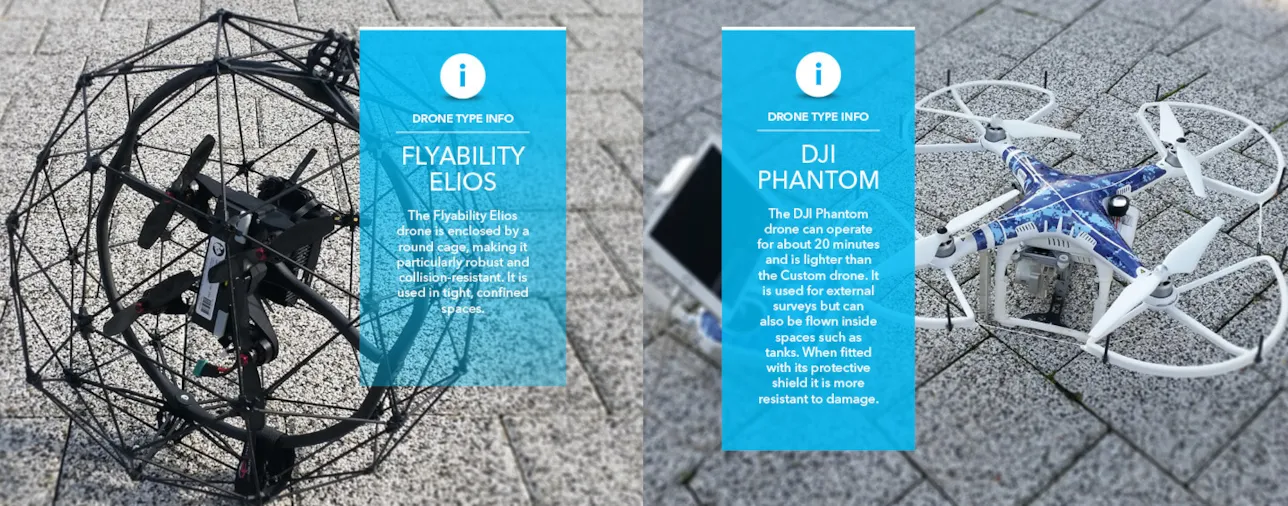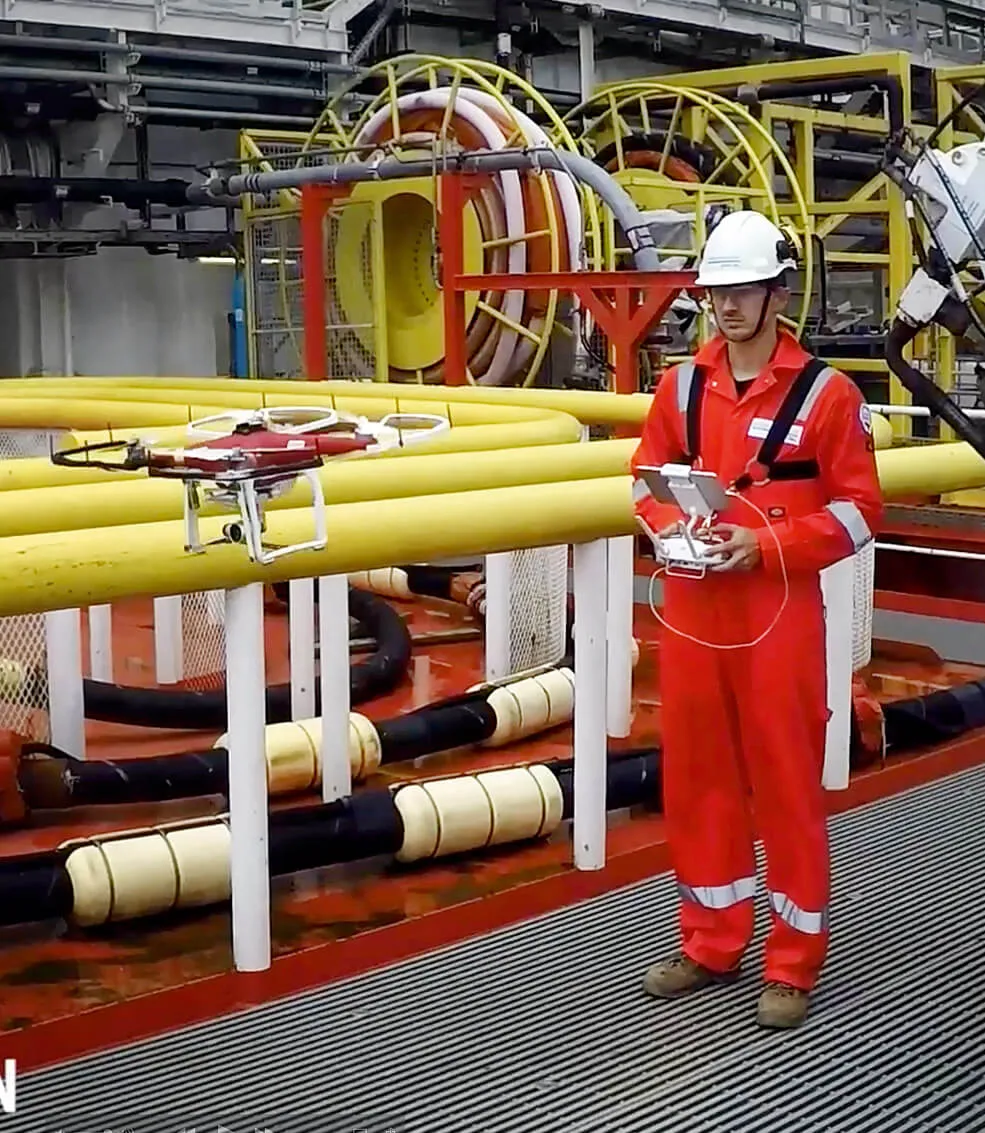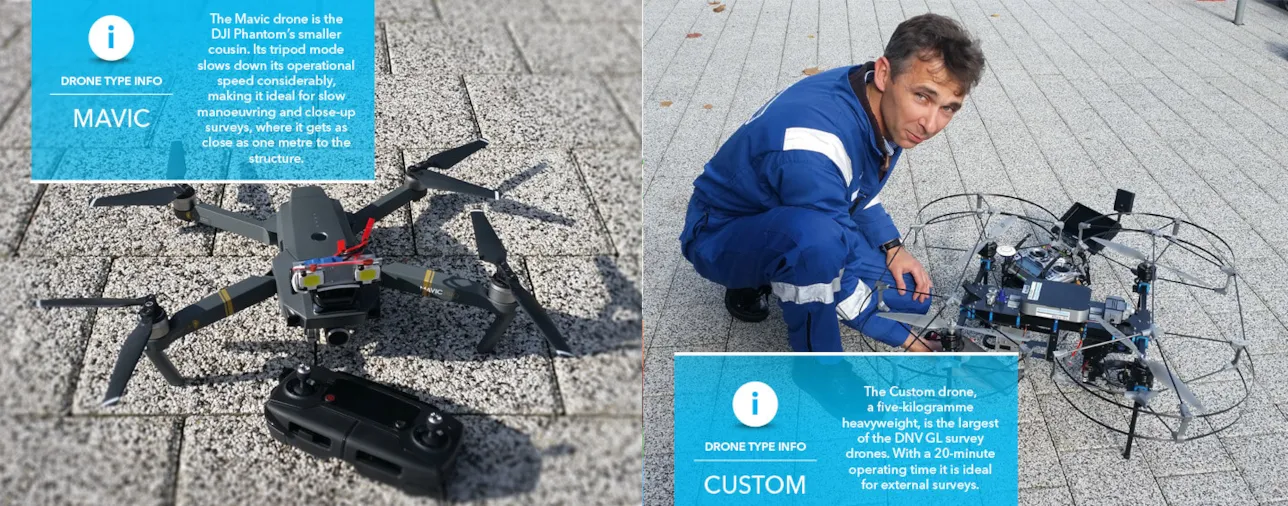The drone squad for ship surveys
With four drone types in its arsenal, DNV GL has adapted its survey technology to various ship structures. Recently DNV GL reached a new milestone with its first offshore drone survey.
It's a gusty day in Gdynia, Poland, and outside the DNV GL station Leszek Alba is waiting for the wind to change. Alba is one of DNV GL’s 16 drone surveyors. Today, he is testing the Custom drone’s stability in different wind conditions and the stability of the video transmission – an important factor during the inspection of remote structural components in tanks and cargo holds.
Since DNV GL carried out its first production drone survey in June 2016, it has become the leading provider in this field. “When we started out, we wanted to find a safer, more efficient and cheaper way of fulfilling the requirements of close-up surveys. During these inspections, a surveyor has to be able to touch a surface to check the condition of the material,” explains Cezary Galinski, Senior Principal Surveyor and Head of the DNV GL drone squad. This global team is headquartered in Gdynia but also works out of Dubai, Shanghai, Singapore and Houston. “So instead of taking the surveyor to the component, we bring the component to the surveyor, on 4k, high-definition video,” he adds. So far the team has conducted more than 25 drone production surveys around the world. Typical ships include tankers, bulkers and, more recently, semi-submersibles and jack-ups. “These are the vessel types that require close-up surveys,” explains Galinski.
DNV GL has four drone types in its arsenal: The Custom drone, the DJI Phantom, the Mavic drone and the Flyability Elios drone – each with different capabilities and areas of application. What they all have in common is that they were modified in Leszek Alba’s workshop. This cellar room, filled with carefully catalogued shelves, spare cables, batteries, soldering irons and a variety drones in different stages of construction, is where DNV GL customizes off-the-shelf drones to make them fit for inspection purposes.


Making a DNV GL drone
“Commercially available drones are built for users who fly them outside in open spaces and shoot footage of objects below. So, one of the first things we do is change the drone’s software settings for adjusting the camera angle. This enables us to film objects that are in front of or above the drone,” says Galinski.
Adding protective gear is the next step. “We have to fly the drones close to ship structures, therefore we developed a special cage for the DJI Phantom drone. And we equipped the Custom drone with a protective wire to shield its propellers, the camera and the lighting systems we attach to it to enable it to operate in dark spaces,” says Alba. Galinski’s team has also fitted the Custom drone with a zoom camera. This means that instead of having to fly within distances as short as one metre from the structure, the drone can take high-definition images from further away.

DNV GL’s first offshore drone survey
This is particularly important when surveyors fly the drone on the open ocean, and has proved to be incremental to the success of DNV GL’s first offshore drone survey, which was carried out on the semisubmersible vessel Safe Scandinavia in July 2017. This tender support vessel (TSV) owned and operated by Prosafe supports Statoil’s drilling operations off the coast of Norway. “It was a great opportunity for us to demonstrate our drone’s ability to check the condition of remote external components in challenging offshore conditions. The inspection only required the semisubmersible to deballast. We flew the drone approximately 25 metres below the main deck to check the condition of the fairleads and their connections to the columns that hold up the TSV. With wind speeds of about 15 knots, this went very well and the survey showed that the fairleads and their connections were in a good condition,” says Galinski.
It was a first for the owner Prosafe as well. “Innovation is one of our core values. We are very pleased to have chosen to try the drone survey, as it helped us optimize our survey requirements and allowed us to save significant amounts of time and money.
'Normally this kind of operation would cause a disruption of several days to our client. The drone survey took only a few hours and was just as effective,” says Ian Young, Chief Operating Officer at Prosafe.

The challenges
To get to this point, Galinski’s team has gone through years of experiments, modifications and practice runs. And even after optimizing the technology, flying drones on maritime structures comes with its own set of challenges. “When inspecting the cargo hold of a large oil tanker, for example, you have to fly the drone about 30 metres away in the dark. In addition, the pilots are surrounded by thousands of tonnes of steel, which means that the drone’s GPS and magnetic compass, which usually help it identify its position, don’t work – nor does its positioning support. This makes its behaviour somewhat unpredictable,” says Galinski. “If you fly a drone in your garden with the position-keeping function enabled, you can push it away and it will automatically return to where it was before. On a ship, any sudden input may cause the drone to become unstable and require the pilot to correct its position manually.” he adds.
During an offshore survey the pilots have to manoeuvre the drone along structures at distances of up to 180 metres. “In this kind of environment the wind is the greatest risk factor. We chose the DJI Phantom drone for the Safe Scandinavia survey, because it can be fitted with a cage. Protecting the drone was important, since we were operating it close to obstacles such as anchor chains and wires. What is great about the DJI Phantom drone is its compact size. It fits into a backpack, making it convenient to take offshore by helicopter,” explains Alba. The successful survey demonstrated that the Custom drone was up to the challenge: it not only survived the inspection but also delivered valuable results.


The future of drone surveys
Looking ahead Galinski expects drones to revolutionize the inspection regime. “I am confident we will see the introduction of autonomous drones. This would open up many new possibilities. For example, they could be dropped into inerted compartments where humans cannot enter,” he explains. The surveyor could stay outside while the drone would follow a predefined flight path to check the condition of the compartment. “This would enable us to carry out inspections without lengthy preparations, while keeping the surveyors safe,” adds Galinski. In future, it might even be possible for an autonomous drone equipped with artificial intelligence to carry out a survey independently, monitored by the surveyor from the shore office using a virtual-reality headset.
For the time being, the autonomous functionality still requires further development. “Outside drones can follow a predefined flight path using a GPS signal. But for confined steel compartments we need to find an alternative approach,” says Galinski. In a joint research project DNV GL and the University of Trondheim, Norway, are developing an autonomous drone. With several options under consideration, Galinski expects to see the first autonomous surveys of inerted compartments in the near future. “Two of our drone pilots have completed the BVLOS (Beyond Visual Line of Sight) certification, allowing them to operate drones beyond the line of sight. So while drone inspections remain a niche for now, more advanced models with AI capabilities could soon transform ship surveys. We want to be ready for this.”
Contact us

